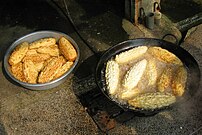[amazon_link asins=’B00JX61AVK,B008X5F8II,B00S02A1UO,B0016LL9IY,B01LW0FVSZ,B0006NZPGA’ template=’ProductCarousel’ store=’finmeacur-20′ marketplace=’US’ link_id=’ac5c54a1-c55a-11e7-92f3-2950d7833f8b’]
Family Name : SCROPHULARIACEAE
Botanical Name : BACOPA MONNIERA
Common Name : HERPESTIS MONNIERIA, THYME LEAVED GRATIOLA, BRAHMI
Part Used : WHOLE PLANT
Habitat : Grows in Marshy places and cultivated South India.
Description: Brahmi or Bacopa monnieri is a perennial, creeping herb whose habitat includes wetlands and muddy shores. Common names include Water Hyssop and brahmi (note: brahmi is also the Ayurvedic name given to Centella asiatica and other herbs).
CLICK TO SEE THE PICTURES….>…...(001)…..(01)...(1)………….(2)………..(3)…..
The leaves of this plant are succulent and relatively thick. Leaves are oblanceolate and are arranged oppositely on the stem. The flowers are small and white, with four or five petals. Its ability to grow in water makes it a popular aquarium plant. It can even grow in slightly brackish conditions. Propagation is often achieved through cuttings.
It commonly grows in marshy areas throughout India, Nepal, Sri Lanka, China, Taiwan, and is also found in Florida and other southern states of USA where it can be grown in damp conditions by the pond or bog garden.
Famed in Ayurvedic medicine, brahmi has antioxidant properties. It has been reported to reduce oxidation of fats in the blood stream, which is a risk factor for cardiovascular diseases.
It has been used for centuries to help benefit epilepsy, memory capacity, increase concentration, and reduce stress-induced anxiety. It is listed as a nootropic, a drug that enhances cognitive ability.
In India, this plant has also been used traditionally to consecrate new born babies in the belief that it will open the gateway of intelligence. Recent studies suggest bacopa may improve intellectual activity
Brahmi is rapidly becoming one of the most sought-after herbs in Australia today, and for good reason! Brahmi is also know as bacopa monniera; also known as bacopa.
Brahmi or Bacopa, is a succulent creeper found throughout India. It is the foremost brain tonic herb of the Ayurvedic healing system used primarily as a nerve tonic, to treat insomnia and nervous tension. Brahmi contains saponins which have been shown to strengthen the nervous system, and decrease insomnia.
Brahmi also has marked hypotensive and diuretic properties and is known as an effective “brain food” as it nourishes the brain and improves intelligence and memory. It is traditionally used as an Ayurvedic rejuvenative or rasayana which helps to decrease the signs of aging, particularly in the mind as it increases mental clarity and brain functioning.
Brahmi is especially suitable for students as it enhances the minds ability to learn and to focus. It has an interesting ability to be able to calm the mind while at the same time to invigorate the thinking capacity in a centered, peaceful way. Brahmi may be useful for people who want to improve mental function and concentration particularly under pressure or in stressful conditions. Brahmi has become especially popular with students and others who need to maintain performance at work or home and has also been recommended for people from middle age on who find their memory is not always as sharp as they would like it to be.
Uses: It is Diuretic, Cardiac, Nervine and Tonic. It is reported to improve intellect, treatment of asthma, hoarseness, insanity, epilepsy. It is a potent nervous tonic and is anti anxiety agent. It is considered good for heart.
TRADITIONAL USES OF BRAHMI
Often taken for fevers and also used for contusions, boils, sprains and fractures. In India the plant is used for all sorts of skin problems- eczema, psoriasis, abscess, ulcerations- it is said to stimulate the growth of skin, hair and nails. Indian Pennywort is also used for chronic rheumatism often as an ointment. In Pakistan, Brahmi is a home remedy for skin problems, rheumatism, piles, inflammations swellings, fever, dysentery, children’s bowel complaints, mental weakness and to improve memory.
Many traditions have employed plants, not only for healing, but also to help us function to our highest potential. An outstanding herb in this category comes from the Ayurvedic, or Indian traditional herbal medicine. Bacopa monniera, also known as Brahmi or Bacopa, is a succulent creeper found throughout India. It is the foremost brain tonic herb of the Ayurvedic healing system.
FROM THE AYURVEDIC TRADITION
Ayurvedic Medicine – practiced in India for over 5,000 years and means “the science of life”. It is a comprehensive form of medicine that combines natural therapies with a highly personalised approach to disease treatment. It places an equal emphasis on body, mind and spirit and strives to restore the innate harmony of the individual.
FOR CLARITY OF THOUGHT
Naturally, a herb with such potential has attracted a lot of interest. Numerous scientific studies conducted by the Central Drug Institute of India CDRI (equivalent to the CSIRO in Australia) have shown Brahmi to improve learning ability retention and enhance results. Results of these studies were presented to the world community at the International Brain Research conferences during 1986-1996. One study for example found that the subjects taking Brahmi took 6 days to learn a specific task whilst the control group (who did not take Brahmi) took a full 10 days to learn the same task. Extensive clinical trials have so far demonstrated no adverse side effects.
Other studies have confirmed that Brahmi has a calming effect for stress and has become the herb of choice for attention deficit disorder A.D.D. in hyperactive children. The calming effect does not interfere with normal physical activities. The active constituents in Brahmi are the all important steroidal saponins known as Bacoside A and B.
Therefore, whilst benefits of this herb on learning and mental performance are of prime importance, Brahmi may also help to relieve the stress of a learning or study environment.
For best results – Adults take 3g (3000mg) once or twice daily continuously and you can expect to see improvements within 4 weeks.
Click to learn more about Brahmi
Source: www.alternativehealth.com & http://www.ayurveda-herbal-remedy.com/indian-herbs/bacopa-monniera.html




















































